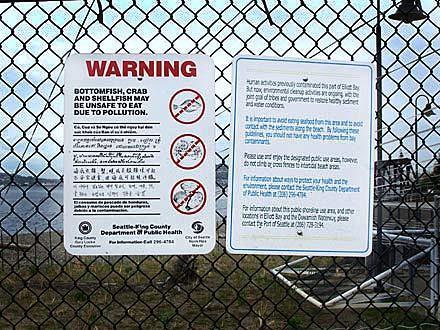Pollution dangers hard to link with human illness, experts say
SIGNS IN MANY LANGUAGES. It's not just that people ignore signs, but many immigrants are illiterate and cannot read their native language, let alone English. In many cases people in non-English speaking communities are accustomed to harvesting shellfish for survival in their home countries and are used to the sickness that often comes with it. Signs along Alki are written in Cambodian, Vietnamese, Laotian, Korean, Spanish, Chinese and Russian. Photo by Rebekah Schilperoort.
Wed, 04/26/2006
Though risks associated with swimming in polluted water are ambiguous among some environmental and health experts, there are signs along Alki Beach that warn against swimming and fishing during and following heavy rains due to risk of sewage overflows, especially likely from May through November.
"You can't absorb (pollution) through your skin," said Stephanie Raymond, education coordinator for the People for Puget Sound. "Maybe if someone swam across the Sound everyday they might pick up something, but you definitely don't want to swallow that water. I wouldn't teach my kids how to swim in there for anything."
The Washington Department of Health has not yet made a link between human sicknesses from swimming in polluted marine waters. However, combined sewer outfalls near Alki Beach put raw sewage in the water and could cause outbreaks through contaminated excrements that infect harvested shellfish, said Lynn Schneider with the Washington State Department of Health BEACH Program, which monitors bacteria levels at recreational beaches.
"In general, our beaches are safe, but I would warn people not to swim or lie on (Alki) after heavy rains because of sewer overflows," said Schneider.
Kim Stark from the King County Department of Natural Resources said it's extremely difficult to associate an illness with a specific activity like swimming.
"People might not realize that their stomachache is caused from swimming a few hours earlier," she said. "There's not a lot of documentation on this."
A report released earlier this month from the Puget Sound Action Team confirms that toxic chemicals like arsenic and mercury that have seeped into the Puget Sound for the past 150 years are a key factor in the Sound's deteriorating health.
The report lists copper, lead, polychlorinated biphenyls (PCBs) and pesticides as a few of the major hormone disrupting chemicals that are released into the Sound through discharge of wastewater, storm water runoff, hazardous waste spills and leaching from landfills.
"We're taking (this situation) very seriously to build a case for working on cleaning up toxics in the Puget Sound," said Anne Criss, a member of the Puget Sound Action Team which worked on the report. "Certain areas of the Sound have low flushing rates, so there is a potential that pollution could stay in that system for a long time."
Near Alki, contaminants attach to sediments and are deposited on the harbor floor. The contaminants, many of them carcinogens from household disposal of pharmaceuticals and personal care products, have affected the reproductive abilities of salmon, shellfish and some bottom-dwelling fish like English sole that spend most of their time near contaminated sediment beds.
But along with the potential detrimental effects to the marine ecosystem, there are serious dangers for humans.
"Eating contaminated shellfish can get you sick immediately, but it's usually something like the stomach flu," said Raymond.
Prolonged consumption of fish that are contaminated can be very dangerous for pregnant women and can cause intergenerational problems for young girls, she said. However, linking human sickness to consumption of tainted fish or shellfish is often a challenge.
"How do you know if people are sick because of fish from polluted waters or from sitting in a plume of exhaust during their commute every day?" said Raymond. There are two issues - what's in that fish, and is it being harvested sustainably? Put those two things together and there's not a lot of fish in my diet."
Because geography plays a big role in where pollution settles, there is some good news.
Alki Beach is a "high energy" area creating less of a chance that contaminants will settle there as opposed to more isolated parts of the Sound where the water has a lower flush rate with ocean water, said Scott Redman, also a member of the Puget Sound Action Team.
"Waves on the beach keep sediments moving at Alki, so there is not a very high sediment build up there," he said.
Beaches like Alki that are located near marinas or wastewater treatment plants are required to be closed to shellfish harvesting and fishing. These closures account for 70 percent of all closures in the state, said Kim Zabel-Lincoln, from the state's Office of Food Safety and Shellfish.
Another danger isn't manmade. Marine biotoxins, which are caused by naturally occurring algal blooms, can cause the most hazardous kind of shellfish poisoning and result in serious human illness or death.
Because algae are food for shellfish, they eat it up and become toxic to humans when the levels of toxin reach a certain amount, said Zabel-Lincoln. Two types of biotoxin illnesses have been documented in Washington: Paralytic Shellfish Poisoning, which can shut down a person's respiratory system and Amnesic Shellfish Poisoning, which can cause amnesia. The last documented deaths from shellfish poisoning was in 1942 when three people died.
State and county health departments, volunteers and local environmental organizations test beaches for biotoxins bi-weekly from May through November when the risk is high.
Rebekah Schilperoort can be reached via wseditor@robinsonnews.com


